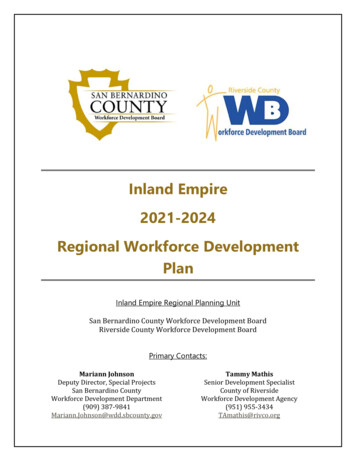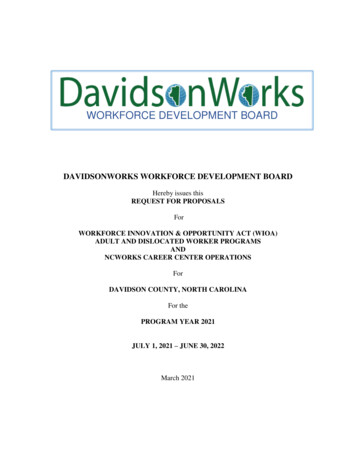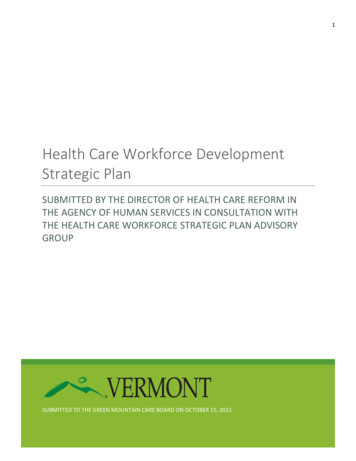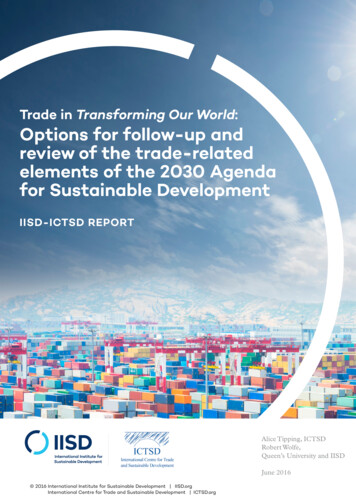
Transcription
Transforming U.S.Workforce DevelopmentPolicies for the 21st CenturyCarl Van HornTammy EdwardsTodd GreeneEditors2015W.E. Upjohn Institute for Employment ResearchKalamazoo, Michigan
Part 1Transforming the U.S. WorkforceDevelopment SystemVan Horn et al.indb 117/30/2015 2:37:38 PM
4Learn and EarnConnecting Education toCareers in the 21st CenturyAnthony P. CarnevaleAndrew R. HansonGeorgetown University Center on Education and the WorkforceBy 2020, 65 percent of job openings will require at least somepostsecondary education and training (Carnevale and Smith 2013).However, not all higher education is created equal: the costs, risks, andreturns on postsecondary education and training programs are highlyvariable. For today’s high school graduates, and an increasing share ofmiddle-aged adults, decisions about whether to enroll in college, whichinstitution to attend, and which program of study to pursue will havecritical economic consequences.As things now stand, however, they are making those decisions inan information vacuum. The U.S. postsecondary education system is akaleidoscope of institutions and interests, and educational policies varyfrom state to state. Most importantly, there is no unified data system thatconnects postsecondary fields of study and degrees with actual labormarket demands. Such a system would enable students to better understand how their training is likely to fit into the real-world job market,and it would also motivate institutions to be more accountable for shaping their programs to fit their students’ needs.The good news is that the data and technology needed to create sucha system already exist, and the costs of integrating them into a unifiedwhole are relatively low. The federal government is the logical place tohouse the exchange: given the frequency with which people, especiallynew college graduates, move across state lines, it would be difficultfor any given state to track its labor market outcomes. Only one majorbarrier remains—a 2008 federal ban on the creation of a student unit77Van Horn et al.indb 777/30/2015 2:38:28 PM
78 Carnevale and Hansonrecord system. Currently, the federal government collects data at theinstitution level, rather than the student level, which prevents users ofthe data from answering questions about what students learned whileenrolled, as well as what happens to them in the labor market after theygraduate, and how outcomes vary for students with different demographic characteristics. Proponents of the ban, largely from the highereducation sector, cite privacy concerns, but colleges and universities arealready legally required to send student-level data to the Departmentof Defense and Internal Revenue Service, and already voluntarily senddata on more than 140 million students to the private National StudentClearinghouse (McCann and Laitinen 2014).The Great Recession left millions of college graduates lookingfor jobs, and since then the media, students, and parents have devotedincreasing attention to the value proposition of postsecondary education. The need for more transparency in the higher education sector hasbecome apparent, and politicians have stepped in. In 2013, SenatorsRon Wyden (D-OR) and Marco Rubio (R-FL) introduced the StudentRight to Know Before You Go Act, which would repeal the federalban on a student unit record system and require postsecondary institutions to report labor market outcomes of their graduates. McCann andLaitinen (2014) detail the political barriers obstructing the repeal of theban, but there is broad bipartisan support.But connecting the dots in the data we already have is only thebeginning. As the time it takes for young people to gain traction in thelabor market has lengthened, we need to find ways to simplify and accelerate the transition from education to careers. This includes strengthening career education, tying the funding of postsecondary educationand training programs with cost and labor market demand, strengthening connections among institutions with education and employmentmissions, and scaling up competency-based education initiatives. Thischapter will outline the new realities of the U.S. labor market andexplore ways in which a learning-labor exchange could help studentsand institutions adapt to those new realities.Van Horn et al.indb 787/30/2015 2:38:29 PM
Learn and Earn 79WHAT WE KNOW ABOUT THE LINK BETWEENEDUCATION AND THE LABOR MARKET On average, more education pays. Over a lifetime, college graduates earn 2.3 million on average, compared to 1.3 million for highschool graduates (Carnevale, Rose, and Cheah 2011). This earningsgap appears to be widening: the wage premium workers receive froma college education—the difference in earnings between high schooland college graduates—increased from 40 percent in 1970 to 84 percent in 2010. Majors and fields of study have an even larger influence on earnings than degree level. Within and across degree levels, people havevastly different earnings: College graduates who majored in the highest-paying fields earnup to three times as much as those who majored in the lowestpaying fields (Carnevale, Strohl, and Melton 2011), making thedifference in earnings between the most- and least-paid collegegraduate greater than the difference between the average collegeand high school graduates. A bachelor’s degree in petroleum engineering translates into amedian annual wage of 120,000, compared with 29,000 a yearfor a bachelor’s degree in counseling psychology. And whiledegrees from prestigious institutions do confer advantages, ateacher with a bachelor’s degree from Harvard still typicallymakes less than an engineer with an associate’s degree from acommunity college. The choice of majors also affects college graduates’ chances oflanding a job in the first place. The unemployment rate of recentcollege graduates for information systems, for instance, wasnearly 14.7 percent, compared to 4.8 percent for graduates whomajored in nursing (Carnevale and Cheah 2013). The importance of field of study is so powerful that workerswith less education in one field frequently earn higher wagesthan those with more education in another. Overall, 30 percentof workers with an associate’s degree earn more than the medianVan Horn et al.indb 797/30/2015 2:38:30 PM
80 Carnevale and Hansonworker with a bachelor’s degree (Carnevale, Rose, and Cheah2011), and one-quarter of male certificate holders earn morethan the median male bachelor’s degree holder (Carnevale,Rose, and Hanson 2012). Occupations also play a strong role in determining wage and employment outcomes. Workers with less education can out-earn thosewith more education if they gain access to high-paying occupations.For example, an engineering technician with an associate’s degreetypically earns more than a high school guidance counselor with amaster’s degree. Within occupations, degree level still matters in determining earnings. Among engineers, for example, an associate’s degree holderearns 65,000 annually, a bachelor’s degree holder earns 85,000,and a graduate degree holder earns 103,000.1THE SHORTAGE OF SKILLED WORKERS AND THENEED FOR A MORE EFFICIENT EDUCATION ANDTRAINING SYSTEMDespite the high average economic returns to higher education, thesupply of skilled workers in the United States has not kept pace withemployer demand (Carnevale and Rose 2011). Since 1983, the demandfor college-educated workers has grown by an average rate of 3 percent each year, while the supply has only grown by 2 percent. As thedemand for postsecondary education and training has increased, highschool graduates have been left behind. Between 1970 and 2010, highschool–educated men’s wages declined by 41 percent (Jacobs 2013a),as young men have lost access to middle-wage, blue-collar jobs in themanufacturing industry and have been forced to shift into lower-payingfood, personal service, sales, and office support occupations (Carnevale,Hanson, and Gulish 2013). In short, the failure of the U.S. human capital development system to adequately develop in-demand skills in itsworkforce has created a paradox: a large number of highly skilled jobvacancies at a time when millions of Americans are looking for work(Jacobs 2013b).Van Horn et al.indb 807/30/2015 2:38:30 PM
Learn and Earn 81Among high school students, college-age young adults, and olderadults, the United States lags substantially behind its peers in literacy, numeracy, and problem solving in technology-rich environments(OECD 2013). U.S. teenagers and high school graduates have weakerbasic skills than their international peers, especially in math, where25 percent score below the baseline level, compared to 10 percent inFinland and Korea (Kuczera and Field 2013). What’s more, they don’tseem to be catching up: between 1994 and 2004, there was no growthin U.S. teenagers’ literacy skills (Desjardins and Warnke 2012). Babyboomers rank average in numeracy skills relative to their internationalpeers, and American teenagers and college-age adults rank dead last innumeracy (OECD 2013).In terms of postsecondary attainment, the United States is actually losing ground to its international peers. The baby boom generationranked first in bachelor’s degree attainment and third in postsecondary attainment internationally, but today’s generation of young adultsranks 12th in bachelor’s degree attainment and 11th in postsecondaryattainment overall.2 The largest room for growth is in career-focusedassociate’s degree programs, where the United States ranks 17th internationally, at 10 percent. By comparison, 25 percent of young adults inCanada earn a career-focused associate’s degree.Under current projections, the United States will need 11 millionmore workers with postsecondary credentials between 2014 and 2020to satisfy the labor market’s demand for college-educated workers.3The recession of 2007–2009 led to the decline of low-skill constructionand manufacturing jobs, replaced by jobs in health care, biotech, nanotech, clean energy, and advanced manufacturing jobs, most of whichrequire at least an associate’s degree (Soares and Steigleder 2012). Thisincreased the level of skills mismatch in the labor market, as formerconstruction and manufacturing workers scrambled to retrain and moveinto different careers (Şahin et al. 2012).Closing the gap between the supply and demand for skilled workerswill pay off in higher wages for workers (due to higher skill levels andproductivity). Higher-paid workers will mean more tax revenue for federal, state, and local governments and less dependency on governmentprograms; more productive workers will boost employer profits andlead to higher economic growth, which benefits everybody. EducationVan Horn et al.indb 817/30/2015 2:38:31 PM
82 Carnevale and Hansoncontributed one-third of the U.S. economy’s productivity gains between1950 and 2000 (Carnevale and Rose 2011). Adding an extra year ofschooling for all Americans by 2025 would increase gross domesticproduct (GDP) growth by between 500 billion and 1 trillion, providing an additional 150 billion in state, local, and federal taxes.4How can we close the gap between the lagging supply of skilledworkers and the growing demand? High school graduates enroll inpostsecondary programs at a high rate (70 percent); the problem is thatnot enough of them actually finish. There are now 75 million Americansin their prime working years (aged 25–54) who do not have a postsecondary credential. Nearly 37 million have some college credit, androughly 15 million have at least two years of college credit. Increasingthe production of the U.S. education and training system by 11 million workers with postsecondary credentials is a feasible task, but itwill require increasing college completion rates as well as developinghigh-quality adult education and workforce development programs toeducate and retrain prime-age workers forced to change careers due tochanging labor market dynamics, as workers shift from blue-collar jobsto high-skill service jobs.The United States comprises three primary sectors charged witheducation and training missions: 1) K–12 schools, 2) postsecondary education and training institutions, and 3) employers. Altogether,they account for roughly 1.6 trillion of spending on human capitaldevelopment: 610 billion on K–12 general education, 483 billion onpostsecondary education, and 528 billion on employer-based training( 164 billion on formal training and 364 billion on informal, on-thejob training).5A lot of those dollars are spent ineffectively. Workforce development programs in this nation, particularly services funded under theWorkforce Investment Act (WIA), are too focused on getting unemployed and displaced workers into jobs instead of engaging them ina long-term skill development strategy, though the evidence demonstrates that this is a less effective strategy (Jacobs 2013a). Unlike itsinternational peers, the United States does not invest in active labormarket policies, such as job training. We rank 28th—second to last—infederal expenditures on workforce training among developed countries,spending only 0.1 percent of our GDP compared to the 0.7 percent average, and 1 percent in Germany and Denmark (Jacobs 2013a). The U.S.Van Horn et al.indb 827/30/2015 2:38:32 PM
Learn and Earn 83workforce development system should operate as part of an ongoingeducation and training system for workers, not merely as a massive jobplacement service.In other developed countries, workforce development institutionslargely operate separately from institutions primarily focused on general, academic education. In the United States, however, this is not thecase—postsecondary programs with academic education and workforce missions are located at the same institutions. In fact, the majorityof postsecondary programs of study are career focused: 57 percent ofpostsecondary degrees and awards are in fields primarily focused onpreparing students and trainees for the labor market.6However, improving education and training will require increasedpublic spending, which makes it politically unfeasible for at least thenear future. More to the point, what we spend now is spent ineffectively. Ours is one of the least productive education and training systems among developed nations, as measured by the postsecondaryattainment rate relative to spending on education and training as a shareof GDP (Carnevale, Hanson, and Gulish 2013). Put more simply, werank 11th in postsecondary attainment despite spending more than anybody else. Most of that spending has been at the federal level: between2000 and 2010, total federal aid to postsecondary education more thandoubled, to 169 billion. At the same time, state expenditures per pupilat postsecondary institutions declined because of budget constraintsand growing enrollment reflecting increased demand for postsecondaryeducation and training (U.S. Department of Education 2012).Proposals to reform education and training in the United Statesshould focus, then, on enhancing the productivity and efficiency of itseducation and training system. Technological innovations have shownsome promise to improve pedagogy and learning, but the best way toenhance productivity is to align education and training programs withthe competencies the labor market demands. As it is, many studentsare making poor choices about what to study, and many postsecondary education and training institutions are funneling students into postsecondary programs of study that do not lead to gainful employment.Jacobson and LaLonde (2013) find, for example, that only one-quarterof Florida community college students complete a degree or certificatewith a moderate or high return. Carnevale, Rose, and Hanson (2012)find that half of postsecondary certificates do not meet that standardVan Horn et al.indb 837/30/2015 2:38:32 PM
84 Carnevale and Hanson(even though certificates do pay off, on average).7 Additionally, amongwomen who either dropped out of college before earning a credential orearned an associate’s degree, 52 percent work in jobs that only requirea high school diploma.8The public should prioritize funding education and training programs that have labor market value. Promoting our citizens’ autonomyas individuals—their ability to access a broad array of cultural goodsand fully participate in a democracy—is an important goal, but it cannot be met until individuals can meet their basic needs. The inescapablereality is that work is central in American society. Those unequippedwith the knowledge and skills necessary to get, and keep, good jobsare denied full social inclusion and tend to drop out of the mainstreamculture, polity, and economy. In the worst cases, they are drawn intoalternative cultures, political movements, and economic activities thatpose a threat to mainstream American life.Moreover, if public money is not spent funding education and training programs that promote access to high-paying careers, it is a missedopportunity to move low-income Americans and other disadvantagedsocial groups into the middle class. It is also a missed opportunity toincrease the skills and productivity of the workforce, which would leadto broader growth and economic prosperity for all Americans.FOUR IDEAS FOR REFORMING EDUCATION ANDTRAINING IN THE TWENTY-FIRST CENTURYPromote Transparency in the Outcomes of Education andTraining Programs by Building a Learning-Labor ExchangeThe most cost-effective way to ensure education and training programs are effectively preparing students and trainees for the labor market is to ensure that students, educators, practitioners, and policymakersare making informed decisions that are in line with their goals. Becausethe costs, risks, and returns to postsecondary programs of study are sohighly variable, we need more quality, coherence, and transparency incost and outcomes.Van Horn et al.indb 847/30/2015 2:38:33 PM
Learn and Earn 85The current major source of data about postsecondary institutions, the Integrated Postsecondary Education Data System (IPEDS),is plagued with problems. It was designed for a postsecondary education system that mostly comprised 18-year-old high school graduateswho enrolled full time at a four-year college or university and graduated from the same institution within three to five years. This meansthat IPEDS does not include data on half of students enrolled at twoyear colleges, outcomes for students who take longer than the typicalcompletion time, the academic preparedness of students, or studentswho have not graduated but are still enrolled. The federal governmentcannot even analyze the effectiveness of Pell Grants, the largest federalinvestment in higher education.9However, addressing the problems with IPEDS still leaves anothermajor problem with the current mechanisms for evaluating postsecondary programs of study: the lack of transparency about the labor marketoutcomes of students and trainees who enroll in and complete postsecondary education and training programs. Building a learning-laborexchange will allow us to assess the extent to which particular education and training programs result in tangible employment outcomes.Such an exchange could be used to track outcomes from early childhoodeducation through high school, postsecondary education, and the workforce. Already, we have earnings data in state unemployment insurance(UI) databases that can be linked to transcript record data using individuals’ Social Security numbers. The Department of Labor’s WageRecord Interchange System facilitates the sharing of wage data acrossstates. In addition, there is the Department of Education’s State Longitudinal Data Systems (SLDS) grant program, which funds state-basedprograms that integrate education data in P-20 data warehouses thatlink student records between pre-K and college into a single system. Ofthe 25 states that have received grants under the SLDS program so far,Florida, Utah, and Texas have developed advanced data systems thatin turn link this education data to workforce and public assistance data(Eyster, Anderson, and Durham 2013). For example, California’s community college system has used these data to develop a “salary surfer”Web tool, which allows students and career counselors to determinetheir likely salaries and probability of finding a job for given occupations and industries.10 Pennsylvania has developed a similar tool calledVan Horn et al.indb 857/30/2015 2:38:34 PM
86 Carnevale and Hanson“Career Coach.” However, these tools have not been established for along enough time frame for researchers to assess their effectiveness.Building a learning and labor exchange would require minimal upfront costs, but those costs would generate long-run savings because ofthe reduced regulatory burden on education and training institutions andthe decreased need for the assorted surveys and disconnected data theyuse now. Vollman and Carnevale (2009) estimate that the start-up costswould be roughly 60 million for the most comprehensive learning andlabor exchange, along with 14 million in ongoing costs, a small fraction of a percent of the 295 billion of public spending on postsecondary education and training each year (Snyder and Dillow 2013).A learning-labor exchange would also minimize the need foraggressive federal oversight or costly state regulations, such as theroughly 850,000 hours that institutions spend annually to comply withthe reporting requirements for IPEDS (Laitinen 2014). However, theinformation system that would most effectively increase the efficiencyof our education and training system is a student unit record system,which would collect data directly from and about students, as opposedto aggregated data from institutions; this practice is currently prohibitedby law.11 Congress should repeal this prohibition in the pending reauthorization of the Higher Education Act. A student unit record systemwould provide unique student identifiers through Social Security numbers that could be connected to from states’ unemployment insurancerecords, which contain data on wages, occupations, and employers. Thetwo information “feedstocks”—transcript records and wage records—needed to build a learning and labor exchange have already been developed, they just need to be connected. Repealing the student unit recordban, along with passage of the Student Right to Know Before You GoAct, which has received bipartisan support, would create the foundationfor a learning-labor exchange that would fundamentally restructure oureducation and training system for the twenty-first century.Another approach would be to create online learning exchanges,in which job-search engines would match job openings and careerpathways to specific courses being offered by traditional postsecondary institutions and online degree programs. These learning exchangeswould promote healthy market competition among postsecondary institutions, which in turn would minimize the need for aggressive federaloversight or expensive state regulation. In other words, greater transpar-Van Horn et al.indb 867/30/2015 2:38:35 PM
Learn and Earn 87ency would lead to more informed consumers and policymakers, whichwould encourage consumers to vote with their feet and institutions tofocus on the labor market value of their programs instead of prestige.The Department of Education is the ideal institution to administerthe learning-labor exchange. First, centralizing the data would createeconomies of scale and cost efficiencies to replace our current system,in which each state runs its own exchange. It would also allow students, families, and policymakers to compare the efficacy of programsof study and institutions across various states. And it is a natural rolefor the federal government to play, given its substantial investments inpostsecondary institutions.But a learning-labor exchange alone will not ensure success at promoting the alignment between education and careers. The next step isto ensure that the high-quality information gets into the hands of thoseit would benefit, via user-friendly tools and information campaigns.Report cards, similar to the Department of Education’s “College Scorecard,” should be published at the program level, and should includesuch information as expected earnings, the job placement rate, theprobability of completion based on students’ characteristics (academicbackground, work experience, interests, financial resources, and familyconstraints), program cost, loan default rate, and median loan amount.12Because career counselors within institutions may not provide objective guidance about the effectiveness of programs of study at their institutions (Kuczera and Field 2013), we need public information tools andinitiatives.Develop Outcome Standards for Education and Training Programsto Ensure the Public Is Getting the Most Bang for Its BuckTransparency itself won’t be enough to move individuals and institutions toward programs with demonstrable labor market value; thereshould also be outcome standards in order to receive public funds.Given the size of its investment, the public has not done enough to holdinstitutions accountable for how public dollars are spent and whethereducation and training programs are effective. This is due to the public’s limited access to information, as well as to the fact that workforcedevelopment programs and postsecondary programs have a variety ofdefinitions for what constitutes successful program outcomes.Van Horn et al.indb 877/30/2015 2:38:35 PM
88 Carnevale and HansonTaken together, this lack of transparency and outcome standardsmeans that ineffective public and private training programs continueto attract trainees and public funds that could be used more effectively.The Obama administration’s proposed Gainful Employment regulationsprovide a framework for establishing a minimum outcome standard forthe receipt of public funds. The regulations are designed to evaluatethe effectiveness of certificate programs at Title IV institutions and alleducation and training programs at for-profit colleges (except liberalarts bachelor’s degree programs). In total, the regulations will apply tomore than 55,000 programs at 5,600 postsecondary institutions (U.S.Department of Education 2011).Employability is an appropriate metric for all postsecondary programs; students ought to know their probability of finding a job andcomparative earnings level after completing a postsecondary programof study. At the same time, gainful employment regulations shouldonly be used to regulate postsecondary programs of study that promise employment and earnings as a direct effect. Programs focused onacademic education, by contrast, can use weighted metrics that alsoinclude assessments of learning.13The core metrics that could be used as outcome standards are earnings, job placement in field, student loan debt default rate, and debt-toearnings ratio. These metrics are better alternatives than completion,cost, and learning metrics alone. For example, completion itself is apoor indicator of success. If an enrollee completes a program and can’tfind a job, or ends up working in a job with lower wages than when shestarted, why should completion be viewed as a success? Why should atrainee who acquires valuable skills and drops out of a training programto work in a high-wage job be counted as a failure? Moreover, maximizing completion rates can be counterproductive if they simply encourageinstitutions to shift enrollments to less-challenging programs or to servethe most-advantaged students. Nursing programs are more difficult tocomplete than cosmetology programs, but some completions are morevaluable than others; nursing graduates are more employable and morehighly paid than cosmetology graduates. Gainful employment metricscan also improve cost metrics by evaluating program costs relative toearnings returns. Nursing programs also cost more than cosmetologyprograms, but the earnings returns are much higher for nursing.Van Horn et al.indb 887/30/2015 2:38:36 PM
Learn and Earn 89Similarly, postsecondary education and training accreditors shouldutilize these metrics in their accreditation standards. At some accrediting bodies, these initiatives are already under way. For example, theAccrediting Council for Independent Colleges and Schools, a majornational career-related education accrediting body, requires accreditededucation and training institutions to report graduates’ job placementrate in their field of study. Institutions must maintain a job placementrate of 60 percent or higher in order to remain accredited. While themajority of postsecondary education and training institutions are subject to academically focused accreditation standards, they should beupdated to align with twenty-first century demands by incorporatinglabor market metrics.Simplify and Accelerate the Transition between Educationand CareersCompared to other developed countries, the transition from high schoolto postsecondary education and training in the United States is lengthyand complex. For example, high school graduates can spend 10 yearsor more navigating the postsecondary system before entering the labormarket, while apprenticeships in European countries generally enrollstudents in their late teens, allowing them to earn while learning andachieve competencies in their target careers by their early twenties. TheUnited States is moving in the opposite direction: here, the age at whichyoung adults gain traction in the labor market actually increased from26 in 1980 to 30 in 2012 (Carnevale, Hanson, and Gulish 2013). Thereare two major logjams: between high school and postsecondary education, and between postsecondary education and career.One reason for the first difficulty is that high school curricula arelargely focused on purely abstract, academic content, so students arerequired to enroll in a postsecondary program of study in order to gai
Georgetown University Center on Education and the Workforce By 2020, 65 percent of job openings will require at least some postsecondary education and training (Carnevale and Smith 2013). . high-quality adult education and workforce development programs to development: 610 billion on K-12 general education, 483 billion on .










